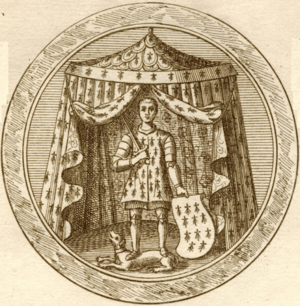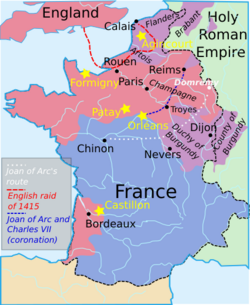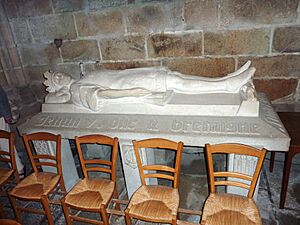John V, Duke of Brittany facts for kids
Quick facts for kids John V |
|
|---|---|

Seal of Jean V
|
|
| Duke of Brittany Count of Montfort |
|
| Reign | 1 November 1399 – 29 August 1442 |
| Coronation | 28 March 1402 |
| Predecessor | John IV |
| Successor | Francis I |
| Regents | Joan of Navarre Philip the Bold |
| Born | Peter of Montfort 24 December 1389 Château de l'Hermine, Vannes |
| Died | 29 August 1442 (aged 52) Manoir de La Touche, Nantes |
| Burial | Notre |
| Spouse | |
| Issue more... |
|
| Family | Montfort |
| Father | John IV, Duke of Brittany |
| Mother | Joan of Navarre |
John V, also known as John the Wise, was the Duke of Brittany and Count of Montfort. He ruled from 1399 until his death on August 29, 1442. He was born on December 24, 1389.
His time as duke happened during the Hundred Years' War. This was a long conflict between England and France. John V managed to make his duchy stronger and keep its independence. He did this by carefully choosing sides in the war and handling problems within France.
John V is sometimes called John VI in older English records. This is because of disagreements about who should have been the rightful Duke of Brittany. This happened during the War of the Breton Succession (1341–1365), which was before his father ruled.
Even though there were some old problems, John V's rule was mostly peaceful. He made the duke's power stronger. He also improved the army and created a better way to collect taxes. He built good relationships for trade and diplomacy with many countries in Western Europe.
John V also supported the arts and the Church. He helped pay for the building of several cathedrals. He is also remembered for starting the "Lycée Lesage" school in Vannes.
Contents
Life of John V
John V was born on December 24, 1389. His birthplace was the Château de l'Hermine. He was the oldest son of John IV, Duke of Brittany, and Joan of Navarre.
When his father died in 1399, John V became Duke of Brittany. He was still a minor, meaning he was too young to rule alone. His mother, Joan of Navarre, acted as regent for him at the start of his reign.
Unlike his father, John V inherited a duchy that was at peace. This was thanks to the end of the Breton War of Succession. However, his father's rivals, the Penthièvre family, still plotted against him. John also had to keep Brittany peaceful during a difficult time. This period ended with King Henry V of England invading France.
Early Years as Duke
John became duke when he was only ten years old. He was guided by Philip the Bold, the Duke of Burgundy. Philip was known for attacking nearby Jersey and Guernsey.
John V made peace with King Charles VI of France. He married Charles VI's daughter, Joan of France. He also made friends with Olivier de Clisson, a powerful noble. Olivier had been an enemy of John's father.
In 1404, John V defeated a French army near Brest. A possible conflict with Olivier de Clisson was avoided when Clisson died.
When Henry V of England invaded France, John V was first allied with the French. But he missed the important Battle of Agincourt. His brother, Arthur de Richemont, fought in the battle. Arthur was captured and imprisoned by the English.
After the battle, there was a lot of confusion. John used this chance to take Saint-Malo, which France had taken over. From then on, he often switched sides between England and France. He signed the Treaty of Troyes, which made Henry V the heir to France. However, he still allowed his brother Arthur to fight for the French.
Abduction by the Penthièvre Family
The Counts of Penthièvre had lost the Breton War of Succession (1341–1364). They had claimed the title of Duke of Brittany from John V's grandfather. The war ended in 1364 with a victory for John's father. The Penthièvre claimant, Charles of Blois, died.
His widow, Joanna, Countess of Penthièvre, had to sign the Treaty of Guérande. This treaty said that the Penthièvres accepted the Montfort family's right to the dukedom. But if the Montforts had no male heirs, the duchy would go back to the Penthièvres.
Even after losing the war and signing the treaty, the Penthièvre family still wanted to rule Brittany. In 1420, they invited John V to a festival at Châtonceaux. When John arrived, he was arrested.
Olivier, Count of Penthièvre, and his mother, Margaret de Clisson, spread rumors that John was dead. They moved him to a new prison every day. John's wife, Joan of France, called on all the nobles of Brittany to help. They attacked all the castles belonging to the Penthièvre family.
Joan ended the crisis by capturing the dowager countess of Penthièvre. She forced her to free the duke. After John was released, the Châtonceaux fortress was completely destroyed. Its name was changed to Champtoceaux.
Because of this failed kidnapping, Olivier lost his county. He was forced to leave Brittany. The Montfort family also declared that the Treaty of Guérande was broken. They said the Penthièvre family no longer had any claim to the throne. This decision helped ensure that Anne of Brittany became duchess later.
John V and the Hundred Years' War
After the English lost the Battle of Baugé, John V changed his allies. He signed a treaty with the French Dauphin Charles in May 1421. In this agreement, John promised to stop supporting the English. Charles promised to remove his advisors who had supported the Penthièvre revolt.
Brittany's military help to Charles was important at first. In the summer of 1421, Brittany provided over a third of Charles's army. This was about the same number of soldiers as the Scots provided. However, the agreement soon fell apart. Both sides did not fully keep their promises.
Also, John's brother Arthur was released from English captivity. The English also had more military successes, especially at the Siege of Meaux. These events convinced John to change his loyalty again. He signed the Treaty of Amiens (1423) with England and Burgundy.
The Amiens agreement also did not last long. Brittany and Burgundy had secretly agreed to stay friends if either of them left the English side. Arthur de Richemont soon joined the Dauphin. He was made Constable of France, a high military rank.
The Duke of Brittany was convinced to do the same. He signed the Treaty of Saumur on October 7, 1425. John V once again allied with Charles. England responded by officially declaring war on January 15, 1426.
The English then attacked Breton land. This attack was led by Sir Thomas Rempston. John V failed to defeat the smaller English force at the Battle of St. James. He was also threatened by a full English invasion. So, John V made peace with them again.
He signed another agreement on September 8, 1427. In this agreement, he again supported the Treaty of Troyes. He recognized Henry VI of England as the king of France. To show his loyalty, he sent his younger son, Gilles, to England. Gilles grew up in Henry's royal household and they became close friends.
However, John V's loyalty to England remained uncertain in the early 1430s. There were fights between English and Breton sailors. But good relations continued because of long talks and the friendship between Henry VI and Gilles.
Even after the alliance between England and Burgundy ended in 1435, John V formally stayed with the English. But he mostly tried to be neutral. He tried to be friendly with the French and wanted to help make peace between both sides.
However, John V took part in the Praguerie revolt in 1440 against Charles VII. He signed a neutrality agreement with the English on July 11, 1440. He promised not to give shelter to England's enemies.
Relations between England and Brittany eventually broke down. This was due to bad diplomacy and English raids into Breton territory in 1443 and 1449. These political events led to the murder of John V's son, Gilles, on April 24, 1450.
When a truce was made between the French and English in 1444, Brittany was not listed as an English ally. By then, John V had already died. His son and successor, Francis I, later paid respect to Charles VII on March 16, 1446. This officially ended any Breton support for the English.
Later Life and Legacy
While he was captured by the English, John II, Duke of Alençon sold his land of Fougères to John V. He did this to get money for his release. After Alençon was freed, he tried to get his lands back. This led to a conflict.
John V surrounded Alençon's fortress during the Siege of Pouancé (1432). His brother, Arthur de Richemont, was with him. Arthur convinced John to make peace.
Working with Bishop Jean de Malestroit, John V began building a new cathedral in Nantes. He placed the first stone in April 1434.
John V died on August 29, 1442. He passed away at the Manoir de la Touche, which belonged to the Bishop of Nantes.
There is a statue of the Duke made of painted wood. It is in the chapel of Saint-Fiacre in Faouët. His original tomb in Tréguier cathedral was destroyed. A new one was built in the 20th century.
Family
John V married Joan of France. She was the daughter of King Charles VI "the Mad" and his wife Isabeau of Bavaria. John and Joan had seven children:
- Anne (born 1409)
- Isabelle (1411–1442), who married Guy XIV, Count of Laval
- Margaret (1412–1421)
- Francis I, Duke of Brittany (1414–1450)
- Catherine (born 1416)
- Peter II, Duke of Brittany (1418–1457)
- Gilles of Brittany (1420–1450), Lord of Chantocé
Succession
John V died in 1442. His oldest son, Francis, became the next Duke of Brittany. He was known as Francis I.
See also
 In Spanish: Juan VI de Bretaña para niños
In Spanish: Juan VI de Bretaña para niños
- Duchy of Brittany
- Kings and dukes of Brittany family tree



